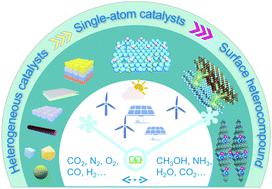当前位置:
X-MOL 学术
›
Nanoscale Horiz.
›
论文详情
Our official English website, www.x-mol.net, welcomes your
feedback! (Note: you will need to create a separate account there.)
Single atom catalysts: a surface heterocompound perspective.
Nanoscale Horizons ( IF 8.0 ) Pub Date : 2020-03-03 , DOI: 10.1039/d0nh00088d Zongkui Kou 1 , Wenjie Zang , Peikui Wang , Xin Li , John Wang
Nanoscale Horizons ( IF 8.0 ) Pub Date : 2020-03-03 , DOI: 10.1039/d0nh00088d Zongkui Kou 1 , Wenjie Zang , Peikui Wang , Xin Li , John Wang
Affiliation

|
The concept of single atom catalysts (SACs) originated from reducing the amount of noble metals used, by steadily refining the particle size loaded on a substrate surface. It has been rapidly moving to non-noble elements and their compounds in recent years, notably transition metals and even non-metals. They are of heterogeneous types, where the active species are refined to atomic dispersion scales on the surfaces/sub-surfaces of the solid support. The catalytic performance is governed by both the type and population of accessible active sites, and their bond and coordination environment, largely as a result of the interactions with the substrate surface. Unlike the internal structure within a crystalline solid, there is a large spatial variation in the bond and coordination environment of different atoms on the solid surface across different length scales, and in particular with the unsaturated surface, where there are various defects. They can also be dramatically altered during both the catalyst synthesis and actual catalysis process. In a way, they form a "surface heterocompound", where the local bonds for each metal atom are of a compound type, while there can be a large variation from one to another. Herein, we will look into the evolution from traditional heterogeneous catalysts to SACs, from the surface heterocompound perspective. Discussion will then be made on the on-going strategies and challenges in manipulating and identifying the local bond and coordination environment on the hetero-surfaces, in an attempt to develop efficient catalysts for the targeted applications, where both synthesis techniques and analytical tools are critically important, and computational studies can provide the key guiding principles. With selected paradigm studies, we will briefly examine the future perspectives for this newly emerging catalysis frontier.
中文翻译:

单原子催化剂:表面杂化合物的观点。
单原子催化剂(SAC)的概念源自通过稳定地细化负载在基材表面上的粒径来减少所用贵金属的量。近年来,它已迅速转向非贵金属元素及其化合物,尤其是过渡金属,甚至非金属。它们是异质类型的,其中活性物质在固体支持物的表面/子表面上被精炼至原子分散级。催化性能受可访问的活性位点的类型和数量以及它们的键合和配位环境的控制,这在很大程度上是与底物表面相互作用的结果。与结晶固体内部的结构不同,固态表面上不同原子在不同长度尺度上的键合和配位环境存在很大的空间变化,特别是在存在各种缺陷的不饱和表面上。在催化剂合成和实际催化过程中,它们也可能发生巨大变化。在某种程度上,它们形成“表面杂化合物”,其中每个金属原子的局部键均为化合物类型,而彼此之间可能会有较大的差异。在本文中,我们将从表面异质化合物的角度研究从传统的多相催化剂到SAC的演变。然后将讨论在操纵和识别异质表面上的本地联系和协调环境方面正在进行的策略和挑战,为了针对目标应用开发有效的催化剂,合成技术和分析工具都至关重要,而计算研究可以提供关键的指导原则。通过选定的范式研究,我们将简要研究这一新兴的催化前沿的未来前景。
更新日期:2020-03-03
中文翻译:

单原子催化剂:表面杂化合物的观点。
单原子催化剂(SAC)的概念源自通过稳定地细化负载在基材表面上的粒径来减少所用贵金属的量。近年来,它已迅速转向非贵金属元素及其化合物,尤其是过渡金属,甚至非金属。它们是异质类型的,其中活性物质在固体支持物的表面/子表面上被精炼至原子分散级。催化性能受可访问的活性位点的类型和数量以及它们的键合和配位环境的控制,这在很大程度上是与底物表面相互作用的结果。与结晶固体内部的结构不同,固态表面上不同原子在不同长度尺度上的键合和配位环境存在很大的空间变化,特别是在存在各种缺陷的不饱和表面上。在催化剂合成和实际催化过程中,它们也可能发生巨大变化。在某种程度上,它们形成“表面杂化合物”,其中每个金属原子的局部键均为化合物类型,而彼此之间可能会有较大的差异。在本文中,我们将从表面异质化合物的角度研究从传统的多相催化剂到SAC的演变。然后将讨论在操纵和识别异质表面上的本地联系和协调环境方面正在进行的策略和挑战,为了针对目标应用开发有效的催化剂,合成技术和分析工具都至关重要,而计算研究可以提供关键的指导原则。通过选定的范式研究,我们将简要研究这一新兴的催化前沿的未来前景。











































 京公网安备 11010802027423号
京公网安备 11010802027423号